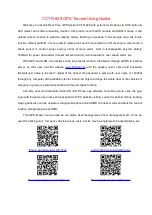
SECTION TWO - Installing the unit
951/952 INSTALLATION MANUAL Revision B
Page 15
Replacement of the fusible link should be performed only by a qualified
electronics technician. If this link becomes open-circuited between the
white and black wires, carefully check all power wiring on the vessel,
especially the white and black wires on the power cable, before removing
the link. You access the link by removing the 10 outer case screws to
open the unit, then removing the four computer-board screws and lifting
the computer board out to expose the I/O board below. The link should
be replaced with another short length of 30-gauge wire.
Installing the antenna
Choosing an
antenna
Three antenna choices are available for the 951X/952X or 951XD/952XD:
•
one for reception of GPS-only signals (the standard one-piece
“active” AN150 antenna)
•
one for reception of both GPS and DGPS signals (a two-piece
antenna system comprising the standard AN150 GPS antenna and
the 8410 DGPS coupler)
•
one for reception of both GPS and DGPS signals (optional one-piece
AN205-P “combination” antenna)
Choosing an
antenna location
Choosing the AN150 antenna location
The GPS receiving antenna is a vital link between the unit’s receiver and
the outside world. Aesthetics and easy access should be secondary to pro-
viding strong and reliable GPS signals to the unit’s receiver. You should
select a location for the antenna that meets the following requirements:
•
The antenna should have a reasonably clear view of the horizon, but
be no higher than necessary (side-to-side motion of the antenna
caused by rolling of the vessel may degrade the SOG and COG read-
ings); however, the antenna should be 12 to 18 inches above the sur-
rounding surfaces to avoid interference.
•
The antenna must be out of the radiation path of any on-board radar
sets or strong magnetic fields.
•
The antenna must be lower than any INMARSAT communications
antenna.
•
The antenna should be as far as possible from other high-power
transmitting antennas.
•
Watch out for electromagnetic “shading” of antennas from rigging,
other vessels, shoreline buildings, and so on. Secure the cable well.
To avoid mutual interferences among different antennas on the vessel,
refer to the recommended separation distances illustrated in Figure 6:
”Separation distances between antennas,” below. This figure shows the
minimum recommended distances for the separation of the GPS antenna
from other antennas and physical mounting surfaces. Under normal cir-
cumstances, following these guidelines usually results in a relatively trou-
Summary of Contents for 951X
Page 2: ......
Page 4: ......
Page 6: ...Page ii 951 952 INSTALLATION MANUAL Revision B ...
Page 8: ...Page iv 951 952 INSTALLATION MANUAL Revision B ...
Page 10: ...Page vi 951 952 INSTALLATION MANUAL Revision B ...
Page 14: ...SECTION ONE Introduction Page 4 951 952 INSTALLATION MANUAL Revision B ...
Page 74: ...APPENDIX A Technical specifications Page 64 951 952 INSTALLATION MANUAL Revision B ...
Page 79: ...Index 951 952 INSTALLATION MANUAL Revision B Page I 5 ...
Page 80: ......
















































